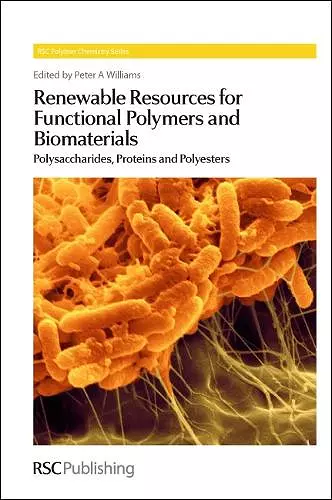Renewable Resources for Functional Polymers and Biomaterials
Polysaccharides, Proteins and Polyesters
Format:Hardback
Publisher:Royal Society of Chemistry
Published:9th Sep '11
Currently unavailable, and unfortunately no date known when it will be back

1. Covers polysaccharides and other important biomacromolecules detailing their source, production, structures, properties, and current and potential application in the fields of biotechnology and medicine 2. Includes a systematic discussion on the general strategies of isolation, separation and characterization of polysaccharides and proteins 3. Aimed at the biomedical and wider materials science communities, the book provides an advanced overview of biopolymers
Covers polysaccharides and other important biomacromolecules, detailing their source, production, structures, properties, and current and potential application in biotechnology and medicine.
This book details polysaccharides and other important biomacromolecules covering their source, production, structures, properties, and current and potential application in the fields of biotechnology and medicine. It includes a systematic discussion on the general strategies of isolation, separation and characterization of polysaccharides and proteins. Subsequent chapters are devoted to polysaccharides obtained from various sources, including botanical, algal, animal and microbial.
In the area of botanical polysaccharides, separate chapters are devoted to the sources, structure, properties and medical applications of cellulose and its derivatives, starch and its derivatives, pectins, and exudate gums, notably gum arabic. Another chapter discusses the potential of hemicelluloses (xylans and xylan derivatives) as a new source of functional biopolymers for biomedical and industrial applications. The algal polysaccharide, alginate, has significant application in food, pharmaceuticals and the medical field, all of which are reviewed in a separate chapter. Polysaccharides of animal origin are included with separate chapters on the sources, production, biocompatibility, biodegradability and biomedical applications of chitin (chitosan) and hyaluronan. With the increasing knowledge and applications of genetic engineering there is also an introduction in the book to nucleic acid polymers, the genome research and genetic engineering.
Proteins and protein conjugates are covered, with one chapter providing a general review of structural glycoproteins, fibronectin and laminin, together with their role in the promotion of cell adhesion in vascular grafts, implants and tissue engineering. Another chapter discusses general aspects of a number of industrial proteins, including casein, caseinates, whey protein, gluten and soy proteins, with emphasis on their medical applications, and with reference to the potential of bacterial proteins. Another natural polymer resource, microbial polyesters, although small compared with polysaccharides and proteins, is also gaining increasing interest in biomedical technology and other industrial sectors. One chapter, therefore, is devoted to microbial polyesters, with comprehensive coverage of their biosynthesis, properties, enzymic degradation and applications.
By dealing with biopolymers at the molecular level, the book is aimed at the biomedical and wider materials science communities and provides an advanced overview of biopolymers at the graduate and postgraduate level. In addition it will appeal to both academic and industrial life scientists who are involved in research and development activities in the medical and biotechnology field.
The structure of the book provides a thorough chapter by chapter overview of the background and basics in each of many different polymers, each written as a review by a range of top interna-tional authors. Each of these chapters covers a wide range of topics including descriptions of their essential properties and characterisations as well a strong focus on the key are-as in which the materials have been applied in the biomedical arena and are drawn from a wide range of sources to provide an excellent overview of each area. Drawn together this provides an excellent, handy and concise handbook that is a timely publication and is an outstanding resource for researchers that are interested in developing natural materials or interested in their biomedical applications. -- Macro Group UK Bulletin - Andrew Dove Macro Group UK Bulletin - REQUEST ONLY
ISBN: 9781849732451
Dimensions: 234mm x 156mm x 25mm
Weight: 816g
440 pages